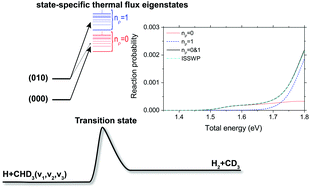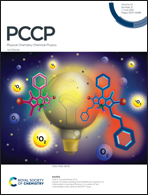The symmetric C–D stretching spectator mode in the H + CHD3 → H2 + CD3 reaction and its effect on dynamical modeling†
Abstract
The symmetric C–D stretching mode is a spectator mode in the H + CHD3 → H2 + CD3 reaction. Effects of multiple vibrational excitations of the CHD3 reactant are studied with the quantum transition-state (QTS) framework and an eight-dimensional (8D) model Hamiltonian developed by Palma and Clary. By including many thermal flux eigenstates, results have been obtained up to high energies, allowing the study of the symmetric C–D stretching spectator mode. A new concept of a state-specific thermal flux operator is proposed to analyze the C–D stretching spectator mode in detail, providing a new and insightful venue for studying transition-state control of chemical reactions. Furthermore, as a spectator mode, whether the C–D stretching motion can be excluded in a seven-dimensional (7D) model has not been fully interrogated, although the 7D model is a reasonable approximation and has provided accurate theoretical predictions. By comparing with available results of full-dimensional calculations, both the 7D and 8D models predict reasonably accurate results. However, the 7D model underestimates the mixing of two vibrational states that are in Fermi resonance. Despite its spectator nature, the C–D stretch is important in the dynamical modeling of chemical reaction systems affected by state mixing.

- This article is part of the themed collection: 2021 PCCP HOT Articles


 Please wait while we load your content...
Please wait while we load your content...